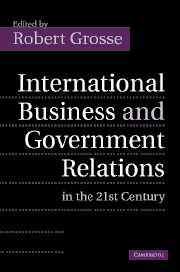Book contents
- Frontmatter
- Contents
- List of figures
- List of tables
- List of contributors
- Acknowledgments
- Introduction
- Part I History and theories of analysis of international business–government relations
- 1 Early US business-school literature (1960–1975) on international business–government relations: its twenty-first-century relevance
- 2 Institutional reform, foreign direct investment, and European transition economies
- 3 Corporate governance in the global economy: international convergence or continuing diversity?
- 4 Revisiting rival states: beyond the triangle?
- Part II The shifting international business–government partnership
- Part III Bargaining theory and the obsolescing bargain
- Part IV Host and home government views of international business
- Conclusions
- References
- Select bibliography of J. N. Behrman's works
- Index
4 - Revisiting rival states: beyond the triangle?
Published online by Cambridge University Press: 22 September 2009
- Frontmatter
- Contents
- List of figures
- List of tables
- List of contributors
- Acknowledgments
- Introduction
- Part I History and theories of analysis of international business–government relations
- 1 Early US business-school literature (1960–1975) on international business–government relations: its twenty-first-century relevance
- 2 Institutional reform, foreign direct investment, and European transition economies
- 3 Corporate governance in the global economy: international convergence or continuing diversity?
- 4 Revisiting rival states: beyond the triangle?
- Part II The shifting international business–government partnership
- Part III Bargaining theory and the obsolescing bargain
- Part IV Host and home government views of international business
- Conclusions
- References
- Select bibliography of J. N. Behrman's works
- Index
Summary
When Susan Strange and I looked into the relationships between firms and States during the late 1980s, we were primarily concerned to signal that the rivalry among States for control over the means of wealth creation had grown to the point where it had overtaken such traditional concerns as control over territory, to become the predominant driver of diplomacy. We argued that States had moved far from the days when suspicion of the multinationals' power had interfered with bargaining relationships, to a position where incentives were being showered on the firms to influence their decisions about where to invest. These were also the days when the UN was still struggling to complete a Code of Conduct for the MNEs (it never succeeded) and when trade talks within the General Agreement on Tariffs and Trade (GATT) were beginning to link trade relationships with the consequences of foreign direct investment (FDI).
We called this “new” diplomacy “triangular” to highlight these growing interrelationships. This was occurring in an era when bargaining power and opinion had swung toward favoring the notion that the MNE was essentially a benign force for economic development. Fears of corruption in the bargaining among executives and government officials had receded. So too had fears about the MNEs' undue interference in internal, domestic policy.
Under these seemingly benign conditions, attention could (usefully, we argued) be focused on all three sides of the triangle to gain greater understanding of the dynamics of the relationships and the conditions for competitiveness.
- Type
- Chapter
- Information
- Publisher: Cambridge University PressPrint publication year: 2005
- 1
- Cited by



